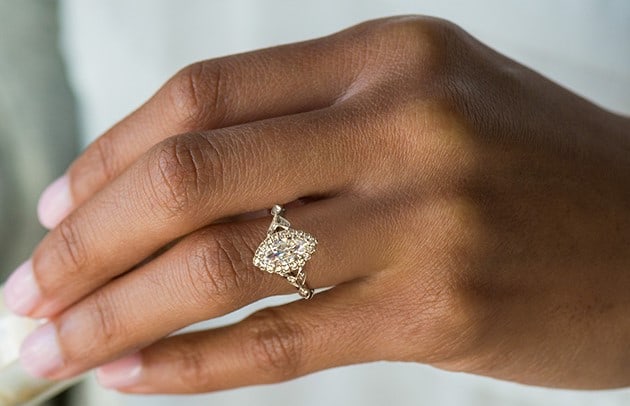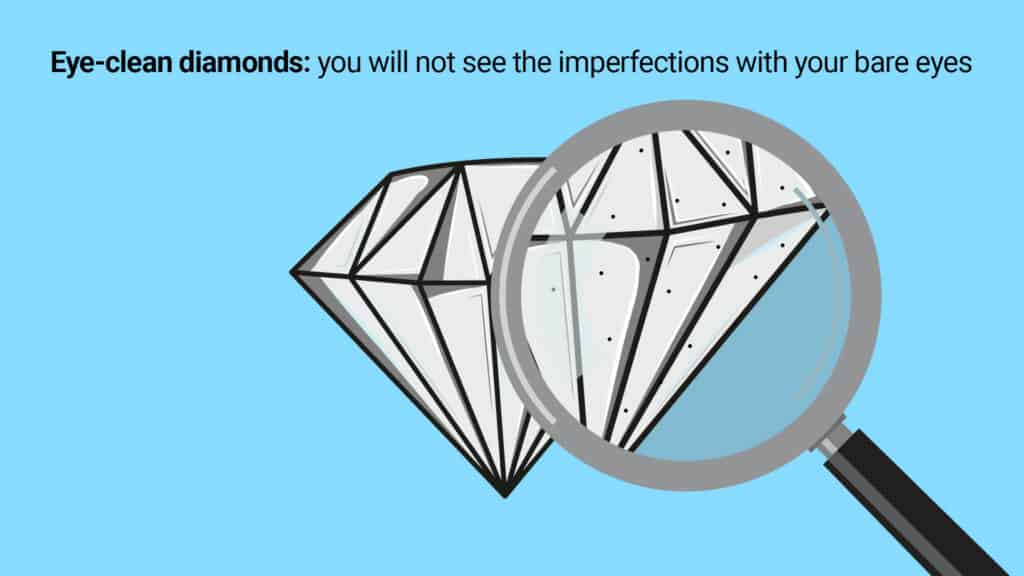With its 56 facets, elongated shape and sharply pointed ends, the marquise cut is a unique and eye-catching diamond shape that can look fantastic in an engagement ring.
As a type of fancy shape diamond, buying a marquise cut diamond can be a more involved and challenging process than buying a round diamond. As such, we’re often contacted by readers in need of expert help choosing a marquise cut diamond to match their tastes and budget.
A few years ago, we received the following email from a reader interested in buying a marquise cut diamond for approximately £1,900. They were looking for a diamond that measured at least 10.5mm in length, with a width of 5.5mm or more.

Here’s the reader’s original email:
“Hi can you please advise me on this marquise stone www.jamesallen.com/loose-diamonds/marquise-cut/1.05-carat-k-color-si2-clarity-sku-4443308?a_aid=dmnd1357
I’m looking for something to set in a custom halo ring in either yellow or rose gold. Diamond size needs to be around a minimum of 10.5 x 5.5 but bigger is good. Budget is tight at no more than £1,900 GBP. Thanks for your help.”
When buying a marquise diamond, it’s important to be aware of several common problems that are unique to this cut. These include a “bowtie” effect that can affect some diamonds, as well as an overly slender cut that can give the diamond a narrow appearance and poor brilliance.
It’s also important to choose a diamond with acceptable color and clarity. In this case, both color and clarity are noticeable issues with the reader’s selected diamond — the K color diamond they have picked has a slight yellow tint and inclusions that are visible to the naked eye.
Finding the Right Marquise Cut Diamond
When buying a diamond, it’s always essential to understand that each shape has its own range of strengths and weaknesses. Certain shapes are great at hiding inclusions, for example, while others are cut in a way that makes even small inclusions extremely obvious.
What color of a marquise diamond should I choose?
Likewise, some shapes are excellent at concealing color, while others need to be looked at very carefully to ensure no color is visible even at a high color grade.
While the marquise cut is fairly good at hiding inclusions (meaning a clarity grade of SI1 or SI2 tends to be the optimal choice for value for money, provided the diamond is eye-clean) it tends to display internal color more clearly than the round brilliant cut.
For this reason, we generally recommend a G or H color grade for marquise diamonds, as this color range provides good value for money while ensuring that the diamond looks colorless to the naked eye.
Going beyond this color grade (for example, choosing D, E, or F color) typically isn’t a good use of your budget, as any improvements in color are so small that they’re effectively impossible to see in normal conditions.

After reviewing this reader’s choice of diamond, we suggested they filter their results to include diamonds with a color grade of H or better, as their original diamond showed some color.
Choosing a colorless diamond is particularly important here, as this reader mentioned that they planned to set the diamond in a custom halo ring. If the center diamond of a halo ring is warmly colored or has a yellow tint, it can clash with the smaller, surrounding halo diamonds.
What about the clarity of a marquise diamond?
This reader sent us a follow-up seeking advice on two marquise cut diamonds: a 0.61 carat, F color, SI1 clarity stone, and a similar 0.65 carat, F color, SI1 clarity diamond, both from James Allen.
Both of these diamonds are significant improvements over their first choice, with superior color that will look excellent in a halo setting.
However, the 0.65 carat diamond (the second diamond linked above) unfortunately has several inclusions that are visible through its table, meaning it won’t appear eye-clean once it’s set in a halo ring.
We always recommend choosing an eye-clean diamond, as visible inclusions can have a huge negative impact on a diamond’s appearance.

Within the SI1 and SI2 clarity range, diamonds can vary hugely in terms of clarity. Certain SI1 or SI2 diamonds are eye-clean in appearance, with clarity that’s comparable to diamonds in the VS (very slightly included) range and more affordable pricing.
However, others, like the 0.65 carat diamond above, will feature small inclusions that are visible when the diamond is looked at carefully.
These inclusions can affect the diamond’s brilliance and transparency, making it important to go with a diamond that’s free of visible inclusions whenever possible.
Detecting small inclusions isn’t always easy, even using the high-resolution image tools that are provided by James Allen and Blue Nile. If you need help reviewing a marquise diamond, or any other diamond shape, for clarity, feel free to contact us to have our experts provide assistance.
Beyond color and clarity, it’s important to carefully check any marquise diamond for a bowtie — a dark space that can stretch vertically across the stone’s center. A dominant bowtie detracts from the beauty of this type of diamond, making it something that’s best avoided.
Bowties can vary in severity. As the GIA explains, “a bow-tie can be light gray to black: The darker and wider it is, the more it can negatively affect the diamond’s appearance.” A dark, large and obvious bowtie can act as a distraction that reduces the impact of the diamond’s brilliance.
For example, this marquise diamond from James Allen features an obvious bowtie that affect its overall appearance:

Both of the diamonds selected by this reader are free of any obvious bowtie, making the slightly smaller 0.61 carat diamond, which has none of the visible inclusions of the larger stone (and, as such, better clarity in a real-life setting), the obvious choice.
Our Recommendation
We recommended that this reader go with the 0.61 carat marquise cut diamond they found with James Allen — something they ended up doing. The diamond is stunning, with excellent overall specifications and a price that’s well within their budget.
It also lacks any signs of a visible bowtie, which is a common issue with marquise cut diamonds due to their elongated shape.
Paired with a halo setting in yellow or rose gold, this diamond can look absolutely beautiful, with excellent cut quality and brilliance.
Finding a diamond can be a challenging process, especially if you prefer a fancy shape such as the marquise cut. If you need help with any aspect of the process, feel free to reach out to us for free assistance.
Every month, our diamond experts help hundreds of our readers compare diamonds and select the ideal stone for their tastes and budget, all at no cost — something we’re also happy to do for you.

- No questions asked returns within 30 days of shipment. James Allen will send you a paid shipping label to return the ring.
- Lifetime Warranty
- Free International Shipping
- Free prong tightening, repolishing, rhodium plating and cleaning every 6 months
- Provide insurance appraisals
- One free resizing within 60 days of purchase
- Free ring inscriptions
- Best-in-class high quality imagery of all diamonds in stock
- 24/7 Customer Service
- Best-in-class packaging


- No questions asked returns within 30 days of shipment. Blue Nile will send you a paid shipping label to return the ring.
- Lifetime Warranty
- Free Shipping
- Free prong tightening, repolishing, rhodium plating and cleaning every 6 months
- Provide insurance appraisal
- One free resizing within the first year of purchase
- High quality images of about half of their diamonds
- 24/7 Customer Service
- 100% credit towards future upgrades (must be at least double in value)
- Best in class fulfillment


